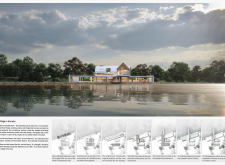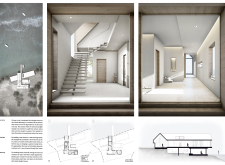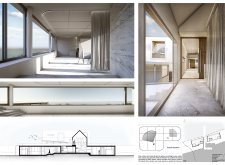5 key facts about this project
At the core of the project's architecture is a comprehensive understanding of its context. The design draws inspiration from local vernacular architecture, incorporating angular roofs and interlocking volumes that echo traditional forms while maintaining a contemporary edge. This careful balance not only respects the cultural heritage of the region but also helps the structure engage dynamically with its natural surroundings. The intentional orientation of the building allows for stunning views of the lake, ensuring that nature remains an integral part of daily life for residents.
The project’s functionality is evident in its layout, which includes both private living spaces and shared community areas. Open-plan living spaces encourage a free flow of interaction, while strategically placed private areas offer a necessary sense of intimacy. This duality supports a lifestyle that fosters relationships without sacrificing personal space. The architectural design incorporates artist studios, reflecting the project’s aim to serve a diverse community with varied interests and backgrounds.
Materiality plays a significant role in reinforcing the project's conceptual framework. The use of wood, concrete, and glass defines both aesthetic qualities and functional attributes, allowing the architecture to resonate with its environment. Wooden cladding brings warmth and a tactile connection to the landscape, while concrete underpinnings ensure stability and resilience against seasonal weather variations. Expansive glass facades allow natural light to permeate the interiors, bridging indoor and outdoor experiences seamlessly.
Sustainability is a prominent theme in the project, informed by a commitment to reduce the ecological footprint of the living environment. The architectural design includes features like rainwater collection systems and ample natural ventilation, promoting responsible resource management. Thoughtful landscaping using native plant species not only enhances the beauty of the site but also supports local biodiversity. These choices illustrate a holistic approach to living that benefits both the residents and the surrounding ecosystem.
Unique design approaches are evident throughout "Village in the Lake." The careful integration of natural elements emphasizes a philosophy of coexistence with the landscape, challenging the common notion of separation between built forms and nature. Pathways leading to the water create inviting transitions that encourage outdoor activities and communal engagement, reinforcing social bonds among residents. Furthermore, green roofs contribute to thermal efficiency and are designed to be accessible, enhancing the potential for communal gatherings in an organic setting.
In summary, "Village in the Lake" is an architectural project that reflects a deep reverence for its context through modern design principles. It embodies a vision where architecture serves as a catalyst for community interaction and environmental stewardship. To fully appreciate the nuances of this project, one is encouraged to explore the architectural plans, sections, and designs that define its character. Engaging with these elements can provide further insights into the innovative architectural ideas that have shaped this remarkable living environment.


























